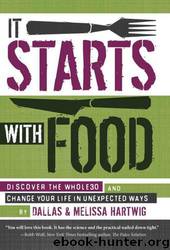It Starts With Food-Discover the Whole30 and Change Your Life in Unexpected Ways by Melissa Hartwig

Author:Melissa Hartwig
Language: eng
Format: mobi
Tags: Non-Fiction, Self Help, Health
ISBN: 9781936608898
Publisher: Victory Belt Publishing
Published: 2012-06-12T05:00:00+00:00
LEAN MEATS
Remember, we recommend eating lean cuts and trimming or draining visible fat if the meat comes from the factory-farming system not because of the saturated fat content, or because the fat in meat is “artery clogging.” It’s the potentially toxic contaminants inherent in the factory-farming system that we’d very much like you to avoid.
Here’s the kicker, however.
Not all the saturated fat in your body starts out that way. It may not even come from fat in your diet at all. This is where we get into the myth that turns out to be true—only not in the way you think.
Was that confusing enough or what?*
Sat-Fat Myth #4: Saturated fat promotes insulin resistance and inflammation.
True.
Some forms of saturated fat (particularly the “long chain” versions) do contribute to insulin resistance and, by extension, inflammation in the body, which does increase your risk for cardiovascular disease and stroke. Palmitic acid (PA) in particular is the type of saturated fat most correlated with insulin resistance and inflammation.
But the form of saturated fat that gets all kinds of ugly in your body doesn’t come from eating saturated fat.
The harmful kind of saturated fat comes from eating too many refined carbohydrates.
Stay with us.
Decades ago, research correlated saturated fat levels—particularly palmitic acid levels—with cardiovascular disease. (The more saturated fat people had in their bodies, the more likely they were to have a heart attack.)
As a result of that research, we were all told not to eat saturated fat because it would lead to heart attack or stroke. We were particularly warned against red meat and eggs, as they happen to be higher in saturated fat than other foods are. The premise was simple: Meat and eggs have lots of saturated fat. Saturated fat is associated with heart disease. Therefore, avoid meat and eggs.
But those recommendations were based on faulty logic.
Let’s break this down, point by point.
Point #1: Identifying high levels of saturated fat, specifically palmitic acid, in folks who had cardiovascular disease does not mean that saturated fat caused the problems. (It’s the old ice cream–shark attack correlation.)
Point #2: It’s impossible to eat palmitic acid all by itself. There isn’t a single food out there—not even palm oil!—that contains only PA. Meat and eggs are high in palmitic acid, sure, but they also contain significant amounts of other fats, like oleic acid (a monounsaturated fat).
Point #3: Other fats, like oleic acid, have been found to prevent palmitic acid from inducing insulin resistance.
So what does this all mean?
Eating whole foods that contain PA is not the same as eating just PA.
Real food (like meat and eggs) contains other fats that help protect your body from too much PA. So there’s basically no way to get a lot of PA into your body all by itself.
Unless …
You eat too much refined carbohydrate.
Download
This site does not store any files on its server. We only index and link to content provided by other sites. Please contact the content providers to delete copyright contents if any and email us, we'll remove relevant links or contents immediately.
Whiskies (Collins Gem) by dominic roskrow(44357)
101 Whiskies to Try Before You Die by Ian Buxton(44107)
World's Best Whiskies by Dominic Roskrow(44053)
Whiskies Galore by Ian Buxton(41561)
The Fast Metabolism Diet Cookbook by Haylie Pomroy(20930)
Chic & Unique Celebration Cakes by Zoe Clark(19809)
Craft Beer for the Homebrewer by Michael Agnew(17953)
The Bone Broth Miracle: How an Ancient Remedy Can Improve Health, Fight Aging, and Boost Beauty by Ariane Resnick(16456)
For the Love of Europe by Rick Steves(11666)
Tools of Titans by Timothy Ferriss(7850)
A Court of Wings and Ruin by Sarah J. Maas(7306)
How to Be a Bawse: A Guide to Conquering Life by Lilly Singh(7175)
The Institute by Stephen King(6815)
Cravings: Recipes for All the Food You Want to Eat by Chrissy Teigen & Adeena Sussman(6664)
Chowders and Soups by Liz Feltham(6328)
Wiseguy by Nicholas Pileggi(5346)
The Last Wish (The Witcher Book 1) by Andrzej Sapkowski(5242)
Spare by Prince Harry The Duke of Sussex(4817)
Room 212 by Kate Stewart(4767)
